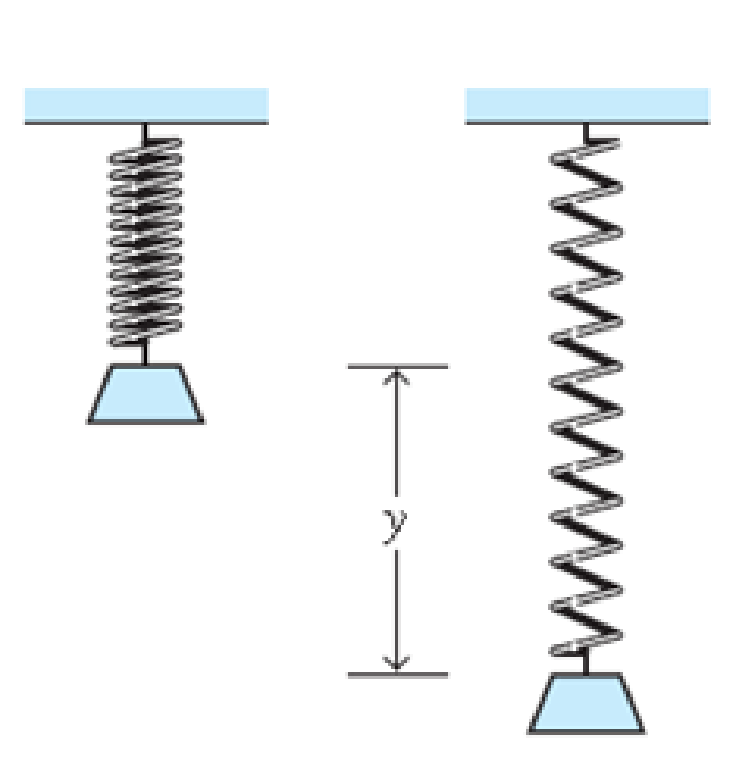
Concept explainers
If a mass m is placed at the end of a spring, and if the mass is pulled downward and released, the mass-spring system will begin to oscillate. The displacement y of the mass from its resting position is given by a function of the form
y(t) = c1 cosωt + c2 cosωt (5)
where ω is a constant that depend s on the spring and the mass. (See the figure below.) Show that the set of all functions described in (5) (with ω fixed and c1, c2 arbitrary) is a

Learn your wayIncludes step-by-step video

Chapter 4 Solutions
Thomas' Calculus and Linear Algebra and Its Applications Package for the Georgia Institute of Technology, 1/e
Additional Math Textbook Solutions
A Problem Solving Approach To Mathematics For Elementary School Teachers (13th Edition)
Pre-Algebra Student Edition
Algebra and Trigonometry (6th Edition)
A First Course in Probability (10th Edition)
Introductory Statistics
Elementary Statistics (13th Edition)
- Calculați (a-2023×b)²⁰²⁴arrow_forwardA student completed the problem below. Identify whether the student was correct or incorrect. Explain your reasoning. (identification 1 point; explanation 1 point) 4x 3x (x+7)(x+5)(x+7)(x-3) 4x (x-3) (x+7)(x+5) (x03) 3x (x+5) (x+7) (x-3)(x+5) 4x²-12x-3x²-15x (x+7) (x+5) (x-3) 2 × - 27x (x+7)(x+5) (x-3)arrow_forward2 Add the rational expressions below. Can you add them in this original form? Explain why or why not. 3x-7 5x + x² - 7x+12 4x-12 Show all steps. State your least common denominator and explain in words your process on how you determined your least common denominator. Be sure to state your claim, provide your evidence, and provide your reasoning before submitting.arrow_forward
- carol mailed a gift box to her sister the boxed gift weighed a total of 2 pounds the box alone weighed 13 ounces what was the wright of the giftarrow_forwardDirections: Use the table below to answer the following questions and show all work. Heights of Females 50.0 51.5 53.0 53.5 54.0 1. What is the average female height? 2. What are all the differences from the mean? 3. What is the variance for the female heights? 4. What is the standard deviation of the heights of the females? 5. What does the standard deviation found in number 4 represent? Write your answer in complete sentences.arrow_forward135 metr uzunlikdagi simni 6:3 nisbatda qismlarga am eatingarrow_forward
- MODELING REAL LIFE Your checking account has a constant balance of $500. Let the function $m$ represent the balance of your savings account after $t$ years. The table shows the total balance of the accounts over time. Year, $t$ Total balance 0 1 2 3 4 5 $2500 $2540 $2580.80 $2622.42 $2664.86 $2708.16 a. Write a function $B$ that represents the total balance after $t$ years. Round values to the nearest hundredth, if necessary. $B\left(t\right)=$ Question 2 b. Find $B\left(8\right)$ . About $ a Question 3 Interpret $B\left(8\right)$ . b represents the total balance checking and saving accounts after 8 years the balance would be 16 / 10000 Word Limit16 words written of 10000 allowed Question 4 c. Compare the savings account to the account, You deposit $9000 in a savings account that earns 3.6% annual interest compounded monthly. A = 11998.70 SINCE 9000 is the principal ( 1+0.036/12)12 times 8 gives me aproxtimately 1997 14 / 10000 Word Limit14 words written of 10000 allowed Skip to…arrow_forwardListen MODELING REAL LIFE Your checking account has a constant balance of $500. Let the function m represent the balance of your savings account after t years. The table shows the total balance of the accounts over time. Year, t Total balance 0 $2500 1 $2540 2 $2580.80 3 $2622.42 4 $2664.86 5 $2708.16 a. Write a function B that represents the total balance after t years. Round values to the nearest hundredth, if necessary. B(t) = 500 + 2000(1.02)* b. Find B(8). About $2843.32 Interpret B(8). B I U E T² T₂ c. Compare the savings account to the account, You deposit $9000 in a savings account that earns 3.6% annual interest compounded monthly. B I U E E T² T₂ A = 11998.70 SINCE 9000 is the principal (1+0.036/12)12 times 8 gives me aproxtimately 1997arrow_forwardWhat are the answers for star powerarrow_forward
 Linear Algebra: A Modern IntroductionAlgebraISBN:9781285463247Author:David PoolePublisher:Cengage Learning
Linear Algebra: A Modern IntroductionAlgebraISBN:9781285463247Author:David PoolePublisher:Cengage Learning
